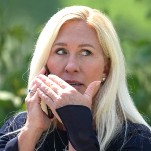How Flight Attendants Organized Against Their Bosses to End 'Swinging Stewardesses' Stereotyping
In DepthIn DepthIn 1971, National Airlines introduced a new slogan: “Fly Me.”
The first print advertisement featured a photographic close-up of Cheryl Fioravante, a freckle-faced stewardess with a boyish coiffure, smiling innocently. “Hi, I’m Cheryl. Fly Me,” the ad read in large, black boldface. Subsequent ads invited travelers to “fly” other fresh-faced stewardesses, like Jo and Laura.
The innuendo-laden campaign cost National a small fortune—they spent over $9 million a year on the ads—but it paid off. The National Organization for Women objected to the ads, calling them sexist, saying that they presented flight attendants as a “flying meat market” and invited passengers to make sexual advances. Nevertheless, the “Fly Me” series raised the carrier’s profile and won a handful of advertising awards.
Advertising the bodies of women employees was good for business. Though the “Fly Me” campaign is now displayed on a number of websites, often as a glaring example of outdated sexism, at the time, “Fly Me” reflected the widespread sexualization of flight attendants, which belied the harsh working conditions that these women negotiated while flying unfriendly skies. That began to change in the mid-1960s when flight attendants mounted an organized push against their employers—and ultimately, improved their workplaces.
The bodies of women flight attendants have long been an integral part of the airlines’ marketing strategy. In the postwar period, government regulations ensured that fares, routes, and planes were nearly indistinguishable. To stand out, airlines marketed their flight attendants’ looks and promised an exciting or erotic in-flight experience. At the dawn of the commercial aviation industry, airlines introduced formal and informal policies to ensure that their flight attendants were uniformly young, slender, unmarried white women, running job ads with explicit requirements for height, weight, and marital status. “Charm farms,” as stewardess schools were often called, taught women how to exercise, walk in high heels, and fashionably style their hair and makeup. They often trained fashion models, as well.
“When we got back from our all-day beauty overhaul, we all burst into tears. We couldn’t believe our eyes: we all looked alike—we were clones of each other!” recalled Betty Turner Hines, a former flight attendant for Pennsylvania Central.
The airline industry enforced the widely held idea that for middle-class women, a job was a short-term stint between college and marriage. They sold stewardessing as a way of acquiring the skills needed as wife and hostess, as well as a means to meet wealthy, white, marriageable businessmen. Former Pan Am flight attendant and NOW President Patricia Ireland wrote in her memoir that during her training in the 1960s, they were constantly told that “the job offered wonderful preparation for fulfillment of marital duties… learning how to make your husband comfortable, how to serve him scotch on the rocks, how to diplomatically handle dinner conversation with his new boss. It was understood that working on an airplane (especially in first class) was a dandy way to meet a man.”
To ensure that being a flight attendant remained a short-term job, not a long-term career, airlines in the 1950s instituted mandatory retirement for stewardesses between the ages of 32 and 35. If these women continued to work for the airlines, they were forced into lower-paying ground jobs. Age requirements drove down wages and prevented career-oriented stewardesses from accruing seniority or benefits. These regulations also aimed to prevent stewardesses from organizing for better pay and work policies.
And then there were the weight regulations. Airlines routinely subjected women working as flight attendants to “weigh-ins” to make sure that they remained slender. At some airlines, supervisors could ask a stewardess to jump on the scale if they didn’t like the way she looked. Trans-Western Airlines representatives insisted these rules were necessary because “a good public image through attractive hostesses is one of the few ways an airline can compete.”
-

-

-

-

-

-

-

-

-

-

-

-

-

-

-

-

-

-

-

-

-

-

-

-

-

-

-

-

-

-

-

-

-

-

-

-

-

-

-

-








































